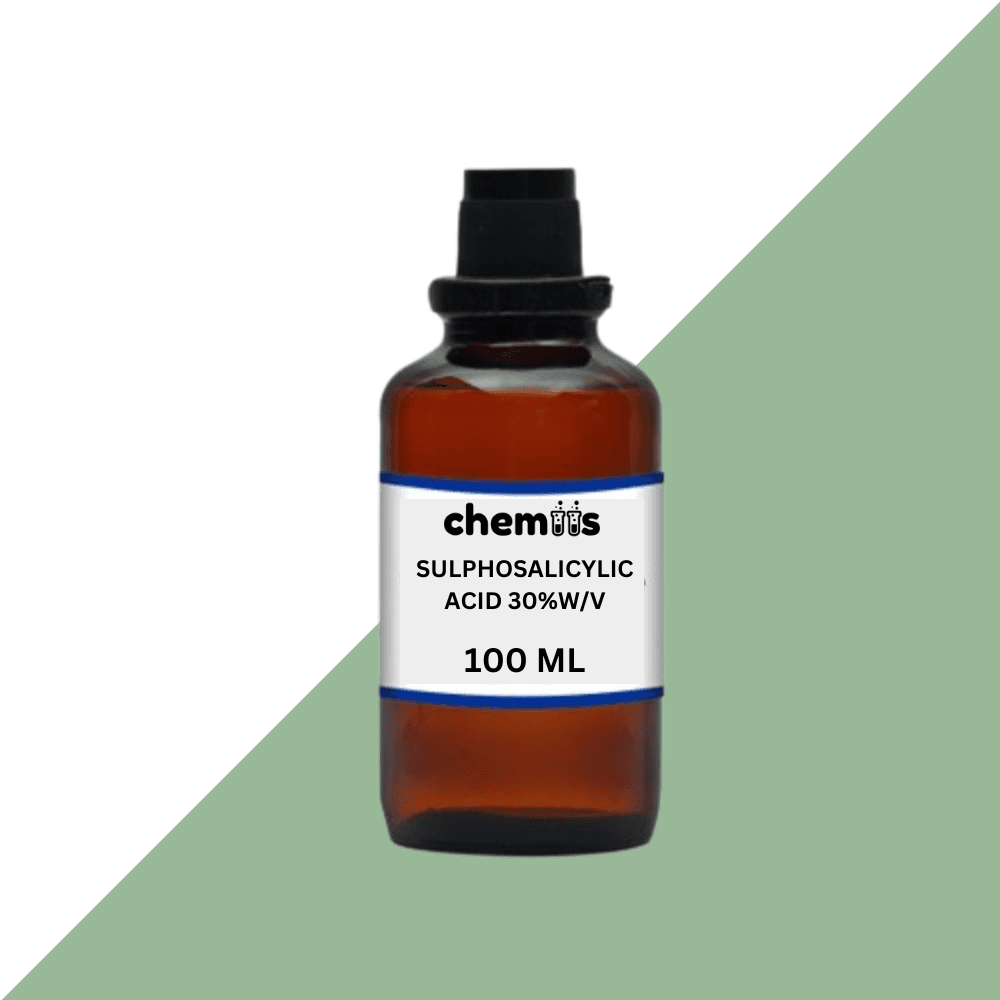Sulphosalicylic Acid 30% W/V is an aqueous solution consisting of 30% Sulphosalicylic Acid by weight, commonly used in analytical and clinical laboratories for protein precipitation and diagnostic testing. It combines the sulfonic acid and hydroxyl group, making it a versatile reagent for precipitating proteins, especially in clinical diagnostics to test for proteins in urine. This concentrated solution is highly effective in isolating proteins from biological samples, enabling clearer results for medical diagnoses, including kidney disorders.
Sulphosalicylic Acid 30% W/V is also employed in chemical analysis, industrial processes, and synthesis of various compounds, playing an essential role in biochemical studies and applications in the pharmaceutical industry.
Applications of Sulphosalicylic Acid 30% W/V:
1. Clinical and Diagnostic Applications:
- Protein Precipitation for Urine Testing: Sulphosalicylic Acid 30% W/V is frequently used in clinical diagnostics to detect the presence of proteins in urine. By adding this solution to urine, proteins such as albumin form an insoluble precipitate. The presence and amount of this precipitate are used to diagnose conditions like proteinuria (excess protein in urine), which may signal kidney diseases, including nephrotic syndrome, glomerulonephritis, or chronic kidney disease (CKD).
- Screening for Kidney Disorders: This solution is a critical tool in the early detection of kidney-related issues. A common method for detecting urinary proteins involves mixing a urine sample with Sulphosalicylic Acid 30% W/V, and if a precipitate forms, it indicates the presence of protein. This method is often used in initial diagnostic testing before confirming with more specific techniques like protein electrophoresis.
- Protein Quantification: Sulphosalicylic Acid 30% W/V is also employed for protein quantification in urine, enabling healthcare professionals to assess the extent of proteinuria and monitor the progression of kidney-related conditions.
2. Laboratory and Research Applications:
- Reagent for Protein Precipitation: Sulphosalicylic Acid 30% W/V is extensively used in laboratory research for protein precipitation. It helps isolate proteins from biological fluids such as blood plasma, serum, and cell culture media, which is crucial for analyzing protein structure, activity, and interactions.
- Biochemical Analysis: This reagent is an essential tool in many biochemical assays, particularly those involving the separation and analysis of proteins. It aids in protein purification processes, which are necessary for subsequent applications like enzyme assays, western blotting, and mass spectrometry.
- Research on Kidney Function: The solution is frequently used in research studying renal function and protein metabolism. By precipitating proteins from urine samples, it helps researchers investigate the biochemical processes related to kidney diseases, drug effects on kidney function, and metabolic disorders.
3. Pharmaceutical Applications:
- Intermediate in Pharmaceutical Synthesis: Sulphosalicylic Acid 30% W/V plays a role in the synthesis of certain pharmaceutical compounds, particularly those related to sulfonamide-based antibiotics. It is used as a building block in chemical reactions that produce other bioactive compounds.
- Antimicrobial and Antiinflammatory Drug Development: Research suggests that derivatives of Sulphosalicylic Acid might have potential applications in the development of antimicrobial and anti-inflammatory drugs due to their ability to inhibit certain enzymes and processes in the body.
- Drug Testing and Formulation: The solution may be used in preclinical testing or drug formulation, especially when developing medications that target kidney diseases or inflammation. It can help simulate biological conditions or act as a reagent in drug efficacy testing.
4. Industrial and Chemical Applications:
- Manufacturing of Dyes and Pigments: Sulphosalicylic Acid 30% W/V is used in the manufacturing of certain azo dyes. These dyes are essential in various industries, such as textiles, food, and cosmetics, where they provide vibrant colors with good colorfastness.
- Chemical Synthesis and Catalysis: As a reagent, Sulphosalicylic Acid 30% W/V is used in the chemical synthesis of various compounds. It can catalyze reactions, especially those involving the sulfonation of organic compounds, which are valuable in creating surfactants, detergents, and other industrial chemicals.
- Surface Treatment: In industrial settings, this solution may be used for surface treatment, particularly in cleaning processes where it is necessary to remove metallic or mineral contaminants from materials.
Safety with Sulphosalicylic Acid 30% W/V:
While Sulphosalicylic Acid 30% W/V is a valuable chemical in various applications, it must be handled with care. Follow the safety guidelines below to ensure safe use:
- Skin and Eye Contact: Sulphosalicylic Acid 30% W/V may cause skin and eye irritation upon direct contact. Always wear appropriate personal protective equipment (PPE) such as gloves, goggles, and lab coats to minimize exposure. If contact occurs, rinse the affected area immediately with plenty of water. Seek medical attention if irritation persists.
- Inhalation Hazards: Inhalation of Sulphosalicylic Acid 30% W/V mist or vapors should be avoided. Always work in a well-ventilated area, such as a fume hood, when handling the solution. If inhaled, move the person to fresh air and seek medical assistance if symptoms such as coughing, shortness of breath, or dizziness occur.
- Storage: Sulphosalicylic Acid 30% W/V should be stored in a cool, dry area away from heat sources and incompatible materials such as strong oxidizing agents. Store the solution in a tightly sealed container to prevent contamination and evaporation.
- Handling: When handling Sulphosalicylic Acid 30% W/V, use appropriate PPE and ensure that the workspace is clean and free from other chemicals. Handle with care to avoid spillage. In case of a spill, use absorbent materials to clean it up and dispose of the waste according to safety guidelines.
- Disposal: Sulphosalicylic Acid 30% W/V should be disposed of according to local environmental and hazardous waste disposal regulations. It should not be disposed of in regular waste systems or poured down the drain. Use certified waste disposal services to ensure safe disposal.
- Accidental Exposure: In the event of accidental exposure (ingestion, skin contact, or inhalation), seek immediate medical attention. Provide details of the exposure, including the concentration and amount of Sulphosalicylic Acid involved. Follow first-aid procedures as recommended for the type of exposure.


















Reviews
Clear filtersThere are no reviews yet.